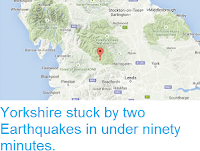A fossil collector has been injured in a landslide at Port Mulgrave on the North Yorkshire coast on the evening of Saturday 27 October 2018. The victim, described as a man in his 40s, received a broken leg and other injuries when part of the cliff collapsed onto him, burying him up to his waist in mud and rock, but was promptly dug out by local fishermen and kept comfortable until the emergency services arrived, eventually being airlifted to James Cook University Hospital in Middlesbrough.
Rescue workers preparing the Port Mulgrave landslide victim to be airlifted to hospital. Staithes Coast Guard.
The incident is the latest in a series of landslips on the North Sea coast of England this autumn, triggered by a long dry summer followed by a wet autumn. In August a woman was injured in a landslip on the Norfolk coast, and a young girl killed in a similar incident at Staithes in North Yorkshire. Since then there have been significant landslides at Saltburn, Cleveland Way and Whitby, all on the same section of coast. Exceptionally dry weather can cause landslides, when exposed soft
sediments that usually contain some water drying out and crumbling,
undermining anything above, but landslips are most common after wet severe weather events,
as excess pore water pressure can overcome cohesion in soil and
sediments, allowing them to flow like liquids.
The cliffs at Port Mulgrove seen from above. UK Fossil Collecting.
The cliffs at Port Mulgrove expose rocks of the Cleveland Ironstone and Whitby Mudstone formations of the Cleveland Basin. These deposits produce both marine and terrestrial fossils of Early Jurassic origin, including numerous Ammonites, Belemnites, and Plants such as Horsetails, as well as less frequent Reptile and Dinosaur remains. Like all erosional coasts, these fossil beds are most productive during bad weather, when frequent landslips on the unstable coastline expose new material. However, this section of coastline is considered to be particularly dangerous, due to poor access to the beach (and, more importantly, poor egress should one get into trouble), the unstable nature of the cliffs, and the uneven nature of the beach below, which is muddy and strewn with large boulders.
See also...
Follow Sciency Thoughts on Facebook.








